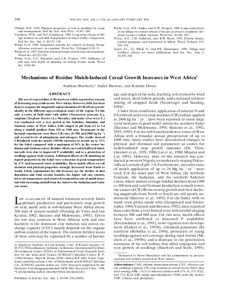Mechanisms of residue mulch-induced cereal growth increases in West Africa
| dc.date.accessioned | 2007-02-09T10:19:18Z | |
| dc.date.available | 2007-02-09T10:19:18Z | |
| dc.date.issued | 2000 | |
| dc.identifier.issn | 0361-5995 | |
| dc.identifier.uri | urn:nbn:de:hebis:34-2007020917116 | |
| dc.identifier.uri | http://hdl.handle.net/123456789/2007020917116 | |
| dc.format.extent | 237468 bytes | |
| dc.format.mimetype | application/pdf | |
| dc.language.iso | eng | |
| dc.rights | Urheberrechtlich geschützt | |
| dc.rights.uri | https://rightsstatements.org/page/InC/1.0/ | |
| dc.subject.ddc | 630 | |
| dc.title | Mechanisms of residue mulch-induced cereal growth increases in West Africa | eng |
| dc.type | Aufsatz | |
| dcterms.abstract | The use of crop residues (CR) has been widely reported as a means of increasing crop yields across West Africa. However, little has been done to compare the magnitude and mechanisms of CR effects systematically in the different agro-ecological zones of the region. To this end, a series of field trials with millet (Pennisetum glaucum L.), sorghum [Sorghum bicolor (L.) Moench], and maize (Zea mays L.) was conducted over a 4-yr period in the Sahelian, Sudanian, and Guinean zones of West Africa. Soils ranged in pH from 4.1 to 5.4 along a rainfall gradient from 510 to 1300 mm. Treatments in the factorial experiments were three CR rates (0,500, and 2000 kg ha^-1)and several levels of phosphorus and nitrogen. The results showed CR-induced total dry matter (TDM) increases in cereals up to 73% for the Sahel compared with a maximum of 16% in the wetter Sudanian and Guinean zones. Residue effects on weakly buffered Sahelian soils were due to improved P availability and to a protection of seedlings against wind erosion. Additional effects of CR mulching on topsoil properties in the Sahel were a decrease in peak temperatures by 4°C and increased water availability. These mulch effects on soil chemical and physical properties strongly decreased from North to South. Likely explanations for this decrease are the decline of dust deposition and wind erosion hazards, the higher soil clay content, lower air temperature, and a faster decomposition rate of mulch material with increasing rainfall from the Sahel to the Sudanian and Guinean zones. | eng |
| dcterms.accessRights | open access | |
| dcterms.bibliographicCitation | In: Journal // Soil Science Society of America. Madison, Wis. 64.2000, H. 1, S. 346-358 | |
| dcterms.creator | Bürkert, Andreas | |
| dcterms.creator | Bationo, André | |
| dcterms.creator | Dossa, Komlan | |
| dc.subject.swd | Westafrika | ger |
| dc.subject.swd | Getreidebau | ger |
| dc.subject.swd | Wachstum | ger |
| dc.subject.swd | Mulch | ger |
Dateien zu dieser Ressource
Das Dokument erscheint in:
-
Publikationen [36]

